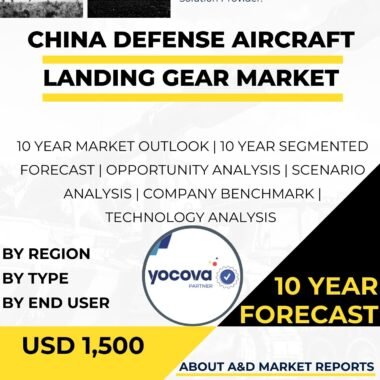Description
South Korea’s involvement in the global auxiliary power unit (APU) market reflects its commitment to advancing its aerospace and defense capabilities. APUs are compact engines that provide auxiliary power to aircraft and other vehicles when the main engines are not running. They play a crucial role in ensuring the functionality of various aircraft systems, such as electrical power, air conditioning, and hydraulic systems, both on the ground and in flight.
South Korea’s investments in the APU market are driven by several key factors. Firstly, the nation’s pursuit of self-reliance in aerospace technology has led to ambitious projects aimed at developing indigenous APUs. By reducing reliance on foreign suppliers, South Korea seeks to enhance its defense readiness, promote technological innovation, and bolster its domestic aerospace industry.
Secondly, South Korea’s commitment to modernizing its military forces, particularly its air force, necessitates advanced APU technology. APUs are integral components of modern military aircraft, ensuring the reliability and efficiency of critical systems. As the nation upgrades its aircraft fleet and develops next-generation platforms, the demand for cutting-edge APUs continues to grow.
Moreover, South Korea’s participation in the global APU market involves collaboration with international defense partners and technology providers. These partnerships facilitate the acquisition of advanced APU technology, knowledge exchange, and collaborative research and development initiatives. South Korea’s position as a hub for APU innovation in the Asia-Pacific region has led to the growth of a robust defense industrial ecosystem.
Furthermore, the nation’s investments in APU technology align with its export ambitions in the defense industry. South Korea aims to become a significant player in the global defense market, exporting APU systems and technologies to international customers. This not only enhances its global standing but also generates revenue and strengthens diplomatic ties.
In conclusion, South Korea’s active engagement in the global auxiliary power unit market underscores its commitment to advancing its aerospace and defense capabilities, fostering technological innovation, and achieving self-reliance in defense technology. As the nation continues to invest in APU research and development, it solidifies its position as a regional and global leader in aviation technology, contributing to both its own security and the broader aerospace industry.
Table of content
Table Of Contents
1 Market Introduction
1.1 Market Introduction
1.2 Market Definition
1.3 Market Segmentation
1.4 10 Year Market Outlook
2 Market Technologies
3 Global Market Forecast
3.1 Global Market Forecast
3.2 By Aircraft Type
3.3 By By Aircraft Size
4 APAC Market Trends & Forecast
4.1 Drivers, Restraints And Challenges
4.2 PEST
4.3 Market Forecast
4.3.1 Market Forecast By Aircraft Type
4.3.2 Market Forecast By By Aircraft Size
4.4 Scenario Analysis
4.5 Key Companies& Profiling
5 South Korea Analysis
5.1 Current Levels Of Technology Maturation In This Market
5.2 Market Forecast
5.2.1 Market Forecast By Aircraft Type
5.2.2 Market Forecast By By Aircraft Size
5.3 Scenario Analysis
5.4 Country Defense Budget (Historical and 10- year forecast)
5.5 Defense Budget Category Spending- 10- year forecast
5.6 Procurement Analysis
5.7 EXIM Data
5.8 Patents
6 Opportunity Matrix
6.1 By Aircraft Type
6.2 By By Aircraft Size
7 Scenario Analysis
7.1 Scenario 1
7.1.1 By Aircraft Type (Scenario-1)
7.1.2 By By Aircraft Size (Scenario-1)
7.2 Scenario 2
7.2.1 By Aircraft Type (Scenario-2)
7.2.2 By By Aircraft Size (Scenario-2)
8 Company Benchmark
9 Strategic Conclusions
10 About Aviation And Defense Market Reports
Segments
By Aircraft Type
By Aircraft Size
List of Tables
Table1: Global Market Forecast, Auxiliary Power Unit Market
Table2: APAC Market Forecast, Auxiliary Power Unit Market
Table3: APAC Market Forecast, By Aircraft Type
Table4: APAC Market Forecast, By Aircraft Size
Table5: APAC, Scenario Analysis
Table6: South Korea Market Forecast, Auxiliary Power Unit Market
Table7: South Korea Market Forecast, By Aircraft Type
Table8: South Korea Market Forecast, By Aircraft Size
Table9: South Korea, Scenario Analysis
Table 10: South Korea Defense Budget 10 Year Forecast
Table 11: South Korea, Defense Budget Category Spending- 10- year forecast
Table 12: South Korea, Procurement Analysis
Table 13: South Korea, EXIM Data Analysis
Table 14: South Korea, Opportunity Analysis, By Aircraft Type
Table 15: South Korea, Opportunity Analysis, By Aircraft Size
Table 16: South Korea, Scenario Analysis, By Aircraft Type
Table 17: South Korea, Scenario Analysis, By Aircraft Size
Figure 1: Market Segmentation, South Korea Auxiliary Power Unit Market
Figure 2: Key Technology Analysis, Auxiliary Power Unit Market
Figure 3: Global Market Forecast, Auxiliary Power Unit Market
Figure 4: APAC, Market Forecast, Auxiliary Power Unit Market
Figure 5: APAC, Market Forecast, By Aircraft Type
Figure 6: APAC, Market Forecast, By Aircraft Size
Figure 7: APAC, Scenario Analysis
Figure 8: South Korea, Market Forecast, Auxiliary Power Unit Market
Figure 9: South Korea, Market Forecast, By Aircraft Type
Figure 10: South Korea, Market Forecast, By Aircraft Size
Figure 11: South Korea, Scenario Analysis
Figure 12: South Korea, Defense Budget 10 Year Forecast
Figure 13: South Korea, Defense Budget Category Spending- 10- year forecast
Figure 14: South Korea, Procurement Analysis
Figure 15: South Korea, EXIM Data Analysis
Figure 16: South Korea, Opportunity Analysis, By Aircraft Type
Figure 17: South Korea, Opportunity Analysis, By Aircraft Size
Figure 18: South Korea, Scenario Analysis, By Aircraft Type
Figure 19: South Korea, Scenario Analysis, By Aircraft Size
Figure 20: Company Benchmark




